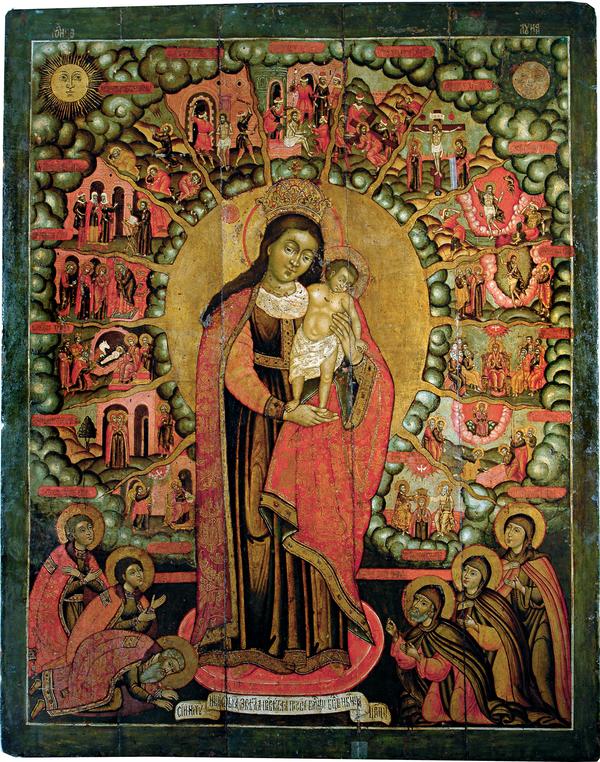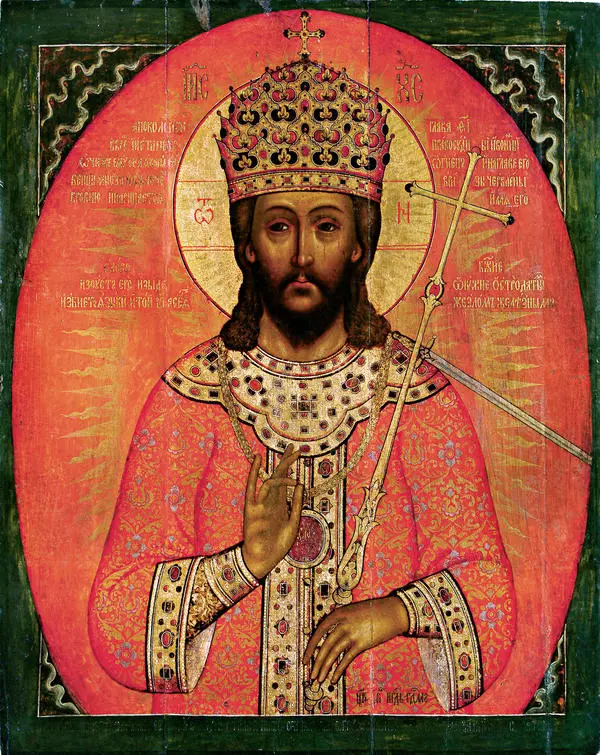The icon Our Lady the Brightest Star was painted by Alexander Kazantsev circa 1690. The iconography of the image was created under the influence of the analects The Most Bright Star translated into Russian in 1686. The analects had fifteen chapters with stories dedicated to miracles taken from the prayer book The Rosary of the Blessed Virgin Mary. This prayer book was introduced by the Dominican priest Alanus de Rupe in the 15th century. It was translated into Russian at the end of the 17th century.
Alexander Kazantsev portrayed the Virgin in full length with her long hair loose. She wears a highly decorated tunic, an ornamented mantle, and a crown. On the Virgin’s right hand there is the baby Christ, who hugs his mother around her neck. The baby holds a Catholic rosary that consists of fifteen beads. The number of beads is equal to the number of prayers in The Rosary of the Virgin Mary. Our Lady and her son look down at their worshipers. The painter borrowed this pose from the Western European iconography.
The figure of Our Lady is in the centre of the star. Between the star rays there are some scenes from the life of the Virgin Mary and Christ. They are symbolically associated with the cycle of prayers from The Rosary of the Virgin Mary. Among the scenes, the most important are the compositions that reproduce European patterns: the Nativity of Christ in the form of the Adoration of the Magi, the Resurrection in the form of the Rising from the Coffin, The Descent of the Holy Spirit with an image of the Mother of God, and a scene of the coronation of the Mother of God. The Ascension with a half-naked Christ saying good-bye to his apostles and The Ascension of Our Lady with apostles surrounding her tomb in the Garden of Gethsemane are of particular interest.
These subjects became widespread in the Russian art of the 17th century. The Russian icon painter added harmoniously the images of Murom wonder-workers St. Constantine, St. Michael, St. Fyodor, St. Peter and St. Febronia, and St. Juliania Lazarevskaya to the occidental composition.
The iconography of the Russian saints depicted in the icon is traditional for the 17th century. St. Constantine and his sons are painted bareheaded. They stand to the right of the Mother of God. St. Juliania is depicted in a religious-like habit with a rosary in her hands. Princes Constantine and Peter as the most revered saints in Murom are represented in a deep bow that symbolizes a fervent supplication. Looking at all of them graciously the Mother of God seems to accept their prayers for the Orthodox Christians.
All the saints’ faces are painted very carefully. Their large figures are depicted in various poses to demonstrate their worship the Holy Virgin, and with different hand motions to create a special dynamics inherent in Alexander Kazantsev’s art works.
Alexander Kazantsev portrayed the Virgin in full length with her long hair loose. She wears a highly decorated tunic, an ornamented mantle, and a crown. On the Virgin’s right hand there is the baby Christ, who hugs his mother around her neck. The baby holds a Catholic rosary that consists of fifteen beads. The number of beads is equal to the number of prayers in The Rosary of the Virgin Mary. Our Lady and her son look down at their worshipers. The painter borrowed this pose from the Western European iconography.
The figure of Our Lady is in the centre of the star. Between the star rays there are some scenes from the life of the Virgin Mary and Christ. They are symbolically associated with the cycle of prayers from The Rosary of the Virgin Mary. Among the scenes, the most important are the compositions that reproduce European patterns: the Nativity of Christ in the form of the Adoration of the Magi, the Resurrection in the form of the Rising from the Coffin, The Descent of the Holy Spirit with an image of the Mother of God, and a scene of the coronation of the Mother of God. The Ascension with a half-naked Christ saying good-bye to his apostles and The Ascension of Our Lady with apostles surrounding her tomb in the Garden of Gethsemane are of particular interest.
These subjects became widespread in the Russian art of the 17th century. The Russian icon painter added harmoniously the images of Murom wonder-workers St. Constantine, St. Michael, St. Fyodor, St. Peter and St. Febronia, and St. Juliania Lazarevskaya to the occidental composition.
The iconography of the Russian saints depicted in the icon is traditional for the 17th century. St. Constantine and his sons are painted bareheaded. They stand to the right of the Mother of God. St. Juliania is depicted in a religious-like habit with a rosary in her hands. Princes Constantine and Peter as the most revered saints in Murom are represented in a deep bow that symbolizes a fervent supplication. Looking at all of them graciously the Mother of God seems to accept their prayers for the Orthodox Christians.
All the saints’ faces are painted very carefully. Their large figures are depicted in various poses to demonstrate their worship the Holy Virgin, and with different hand motions to create a special dynamics inherent in Alexander Kazantsev’s art works.





